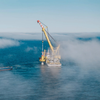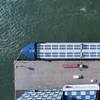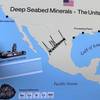Naval Architecture: The Future is Now Forget Gas & Diesel ... Break Out the Limbs!
The David Taylor Model Basin was homeport for some curious looking contraptions recently, human powered submarines, which were designed and built by perhaps the next generation of naval architects and marine engineers. John Hussey reports.
High-tech met low-tech, and college engineers competed against standout high school students in the seventh running of the International Submarine Races, the biennial human-powered engineering design competition completed at the world's largest indoor tank, the Naval Surface Warfare Center's Carderock Division David Taylor Model Basin, June 23-27, 2003.
Drawing upon both brain and brawn, the scuba-clad future engineers and design entrepreneurs produced a range of submarines from the sublime to the surreal, all built to move forward on a 328-ft. (100-m) course, 20 ft. (6 m) deep, powered by human energy alone.
The team chosen by judges to receive the top award for Overall Performance was Omer of the University of Quebec's Ecole de Technologie Superieure, Montreal, Canada. "Omer 5", the team's remarkably sleek 16-ft. submarine, won the Absolute Speed Award with a sprint of 6.8 knots in the two-person propeller category, and also won the prize for Best Use of Composites. The Overall Performance Award, sponsored by the IEEE Oceanic Engineering Society, carries a cash prize of $1,000 and a trophy.
The prize for Innovation went to independent contestant Bruce Plazyk of Wheaton, Ill., who created a one-person submarine called "Faux Fish." The "vessel" resembles a mechanical fish, complete with an articulating tail and a pumping system for propulsion. The Spirit of the Races Award went to the team from Florida Institute of Technology, whose submarine, "Miss FIT", was a bright red 16-ft.-long creation that looked like a six-sided torpedo. This award recognizes overall spirit, gusto, fortitude and support of other teams and is given in honor of the late ISR contestant Steve Barton of Spring Hill, Fla.
Judges awarded the Best Design Outline and Report prize to Sussex County Technical High School of Sparta, N.J., whose first-time entry, "Umptysquatch-1" was completely designed, built and operated by high school students. A new prize, the Smooth Operator Award, went to "Sirius" from the University of Washington. The award recognizes overall team efficiency in handling their sub into the water and below the surface.
The competition featured 19 submarines from teams throughout the U.S., Canada and Mexico, including two high schools and several independents. More than 150 volunteers provided the resources required to conduct the races, including U.S. Navy safety divers from Little Creek, Va., and experts from the Carderock Division staff.
Competition commenced with the first submarine in the water ready for safety checks. Ahead of the more experienced college teams was "Sublime II" from Springstead High School in Spring Hill, Fla. Attempting to take its first run, however, the Florida team made it to the starting gate, only to run out of air. But they were soon back in the racing, finishing with a number of successful runs and achieving a speed of 2.1 knots. Safety is a key element of the competition. U.S. Navy divers line the course, ready to help extricate the crews in case of trouble. Each sub is built with a quick-release hatch, easily pulled free to allow crew members to escape if necessary.
Crashing into walls due to navigation mishaps was not uncommon, occurring to a number of vessels including the sleek sub named "Invicid" from the University of California at San Diego, which on one of its runs veered sharply and shattered its nosecone against the wall.
But in the spirit of the races, other teams came forward with offers of help and after repairs, the sub was back and running again within hours.
At the ISR, propellers break, shear pins snap, hatches float off, guidance fins sometimes don't work and control mechanisms jam or break. A frequent challenge is the achievement of neutral buoyancy, permitting the sub to attain a level position to start its run. These were just a few of the mishaps and that befell the teams and become learning experiences as they sought to take their inventions from the concept level of classroom, laboratory and workbench into the unforgiving underwater environment of the test tank.
Jerry Rovner, race director, said the ISR operations team conducted 189 individual submarine runs during the five-day event. "It's to be expected that submarines will have breakdowns. That's the nature of building a complex machine and trying to make it work 20 ft. underwater. We're pleased to note that for safety, our record remains 100 percent intact," he said. Rovner manages the process of all race operations including diving, safety, emergency procedures, course lighting, underwater video and timing, "This was the smoothest operation we've ever run. We owe a huge debt of thanks to the Navy, to our volunteers and to the submarine teams."
Team Omer from Montreal, Quebec, which holds the world's record for speed in both one- and two-person submarines, brought a brand new submarine to the race, dubbed "Omer 5". The Canadian team was unable to make its first run until Thursday, due to computer problems, but then achieved a blistering speed of 6.814 knots. "Omer 5" is an incredibly sleek, two-person submarine outfitted with sophisticated, computer-driven speed and directional aids for the propulsor and navigator. The sub has a breakthrough propulsion system, which enables both occupants to provide human power. Team officials had hoped to be able to break the eight-knot barrier, but technical problems got in the way.
Among those competing here for the first time was Sussex County Technical School from New Jersey. The team designed and built a 12-ft. (3.6-m), two-person sub that not only moved successfully through the course but achieved a speeds of 2.3 knots from its twin propeller propulsion system. The team achieved such popularity that race officials engineered a special challenge contest, giving U.S. Navy divers a chance to operate the sub and see if they could match the time of the students. To the good-natured gibes of spectators, the veteran Navy divers failed to finish the course. One of the most innovative entries was a team from Virginia Polytechnic Institute, Specter 1, which featured a composite nosecone wrapped around a one-person propulsor who provided thrust by wriggling a dolphin-like fin attached a neoprene skirt encircling the legs. It was the first half-human, half-fish entry seen in the 15-year history of the ISR. It achieved a speed of 3.5 knots and claimed a new world's record for human-powered alternative propulsion submarines. Virginia Tech's more traditional one-person sub, Phantom 4, made a speed of 3.8 knots. This was the fourth time that the event was staged in the 3,200-ft.-long David Taylor test tank at NSWC. The ISR was created in 1988 with an open invitation to inventors and entrepreneurs of all stripes, and the first race was held at Singer Island, Fla., the following year. The competition moved to Carderock in 1995, growing to include the participation of universities, colleges, corporations, research centers, high schools and privately sponsored teams from the United States, Canada, Mexico and Europe. Typical teams consist of student athlete/engineers, wearing scuba gear, who provide propulsion and navigation as their subs run against the clock along a fixed underwater course. The principal objective of the competition is education: to encourage innovation in the use of materials, hydrodynamic design, resistance, buoyancy, propulsion and underwater life support. ISR officials noted that many team participants have gone on to professional engineering careers in the Navy and other ocean technology organizations in the 15-year history of the competition.
"The increasing interest among young people to compete in educational arena of human-powered submarines is gratifying," said Nancy Hussey, chairman of the Foundation for Underwater Research and Education, parent organization of the ISR. "To design and complete a racing submarine is a very difficult challenge. Taking an idea from paper and classroom theory to actual practice in the water demands the very best minds and ultimately, good teamwork and experience. We look forward to our next competition in 2005 and are delighted at the success of our partnership with the U. S. Navy here at the Naval Surface Warfare Center's Carderock Division."









